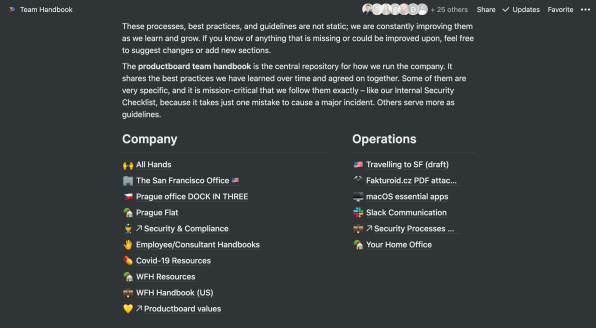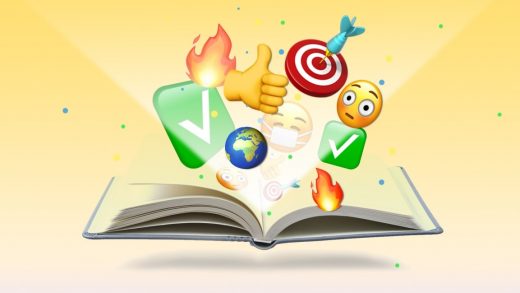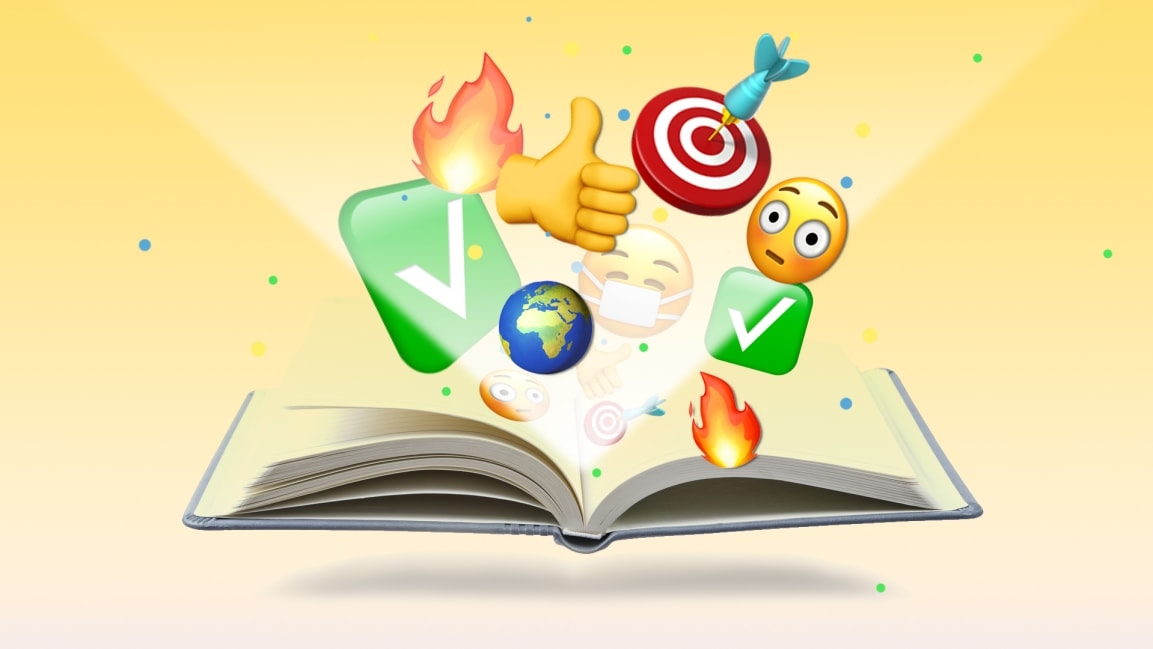Why workplaces need to embrace emojis now
Does this make you feel ![]() or
or ![]() ? Have you joined a company that speaks your language or are you suddenly regretting that decision to leave your previous, decidedly non-emoji-using firm?
? Have you joined a company that speaks your language or are you suddenly regretting that decision to leave your previous, decidedly non-emoji-using firm?

I have a lot of direct experience in this as the image at the top of this post is an excerpt from my company’s actual Employee Handbook. Productboard is an emoji-lovers heaven ![]() and many people who work here have told me that seeing the Employee Handbook on day one confirmed that the company was a perfect fit
and many people who work here have told me that seeing the Employee Handbook on day one confirmed that the company was a perfect fit ![]() .
.
Emojis have long been dismissed as unprofessional and best kept out of the workplace. But I believe that the time has come for all businesses to embrace these little icons of emotion ![]() .
.
Millennials and post-millennials now make up at least 65% of the workforce in the U.S. Emojis are an essential part of how most of this generation communicates in their personal life. Businesses typically view communication skills as highly valuable in employees, so why suppress such an important tool? ![]()
Effective communication is even more critical as businesses become ever more distributed. Productboard has offices in San Francisco, Vancouver and Prague, as well as remote teams all over the world. Emojis have been integral to how we connect and build bonds with one another across ![]()
![]()
![]()
![]()
![]() geographical divides.
geographical divides.
The impact of COVID-19 ![]() has created more remote teams as even people based near one of our offices are working from home. It has made our ability to communicate emotionally, honestly, and efficiently using digital tools even more critical. Here’s how emojis play such a
has created more remote teams as even people based near one of our offices are working from home. It has made our ability to communicate emotionally, honestly, and efficiently using digital tools even more critical. Here’s how emojis play such a ![]() role in achieving this.
role in achieving this.
Instant context
Productboard runs on Slack. We manage projects, coordinate teams, share information and chat with our colleagues almost entirely through the platform’s short, speedy messages. ![]()
This means that most of our communication is brief and to the point. We don’t spend a lot of time finding the right words to convey the kind of context and tone you get from a face-to-face conversation. That’s what emojis are for ![]() .
.
Adding an emoji to your message extends that person-to-person experience to text-only communication. They are a simple shortcut to avoiding the type of misinterpretation that is so common in email![]() .
.
With one simple icon you can show that you’re joking about something, that your request is polite or that feedback is intended to be constructive rather than critical ![]() .
.
As companies become more dependent on short, asynchronous conversations, emojis can provide much-needed emotional ![]() support.
support.
Visual cues
While people take in new information in different ways, the majority of us are visual learners. Our brains are designed to process visual information quickly and we process and interpret symbols in milliseconds.
For the same reason that we use icons as a visual aid on screens, signs and documents, everyone at Productboard uses emojis to help deliver complex information quickly. We even highlight specific emojis that people should use to respond to messages quickly in our Slack best practices guide ![]() ? ?
? ? ![]() .
.
Sending a ![]() not only saves you time typing “great job.” the recipient understands the message faster. For us,
not only saves you time typing “great job.” the recipient understands the message faster. For us, ![]() doesn’t just mean “look at this,” it’s a more elaborate idea that says, “I’ve seen your request and will respond to it.”
doesn’t just mean “look at this,” it’s a more elaborate idea that says, “I’ve seen your request and will respond to it.”
If I ask someone to do something and add a ![]() to my request, that person instantly knows it relates to a specific target or objective and can prioritize accordingly.
to my request, that person instantly knows it relates to a specific target or objective and can prioritize accordingly.
Emojis supply a simple, visual shorthand that makes us more ![]() effective and productive communicators.
effective and productive communicators.
Customizing our culture
Slack allows you to import your own custom-created emojis. You won’t be surprised to learn that we use a lot of these ![]()
![]()
![]() at Productboard.
at Productboard.
I know of one team who created an emoji around a funny YouTube video they all watched while working late one night to meet a deadline. Now they can reference this bonding moment in one simple image. ????
We’ve also created emojis for each of our company values. This gives us a fun and easy way to give someone props for living up to one of them without sounding pompous while making our values more accessible and relevant to everyone![]()
![]() ??
?? ![]()
![]() .
.
Using custom emojis helps us to forge cultural bonds. They’re especially useful at overcoming cross-cultural differences, especially when some cultures have different interpretations of an emoji’s meaning (I use ![]() to say thanks and some people think I’m praying for them).
to say thanks and some people think I’m praying for them).
By creating our own emoji-based language, Productboard is developing a unique company culture we all understand that helps make us one tribe, no matter where we’re based. ![]()
![]()
![]()
Emoji for empathy
When your team is based in different places, have diverse backgrounds, and may not even have met in person, you need to help them get to know and understand one another. Emojis are a great way to establish this much-needed empathy ![]() .
.
As a leader, I want emojis to be part of how my company communicates because I want the meanings of my messages to be clear and to resonate with people. And because I use emojis to express myself, it gives everyone else the permission they sometimes need to use them in the workplace ![]() .
.
Together, we’re evolving a way of communicating that uses emojis to bring our distributed teams together and create a unique company culture that helps us achieve our goals ![]()
![]()
![]() .
.
Hubert Palan is the founder and CEO of Productboard, a customer-driven product management system.
(35)



